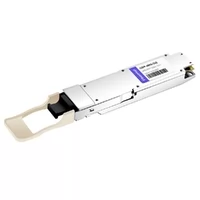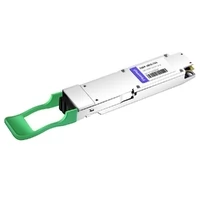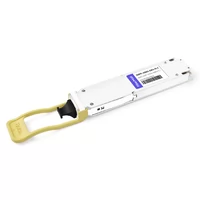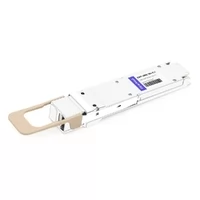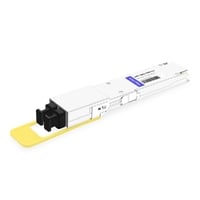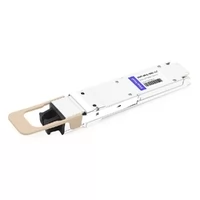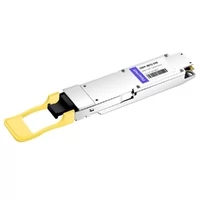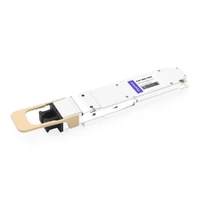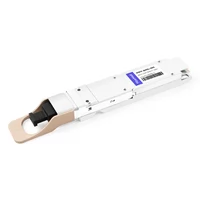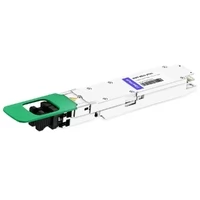Octal Small Form-factor Pluggable transceivers (OSFP) are a type of sophisticated optical module that can transmit data at a higher speed of up to 400Gbps. These devices are essential to any modern data center infrastructure as they provide the bandwidth for handling the ever-increasing amounts of traffic and complex applications. Each OSFP transceiver has eight electrical lanes, which operate at a rate of 50 Gbps per lane to achieve an overall speed of 400G through PAM4 (Pulse Amplitude Modulation) technology. Hot-swap capability is one significant characteristic among other features found in OSFP modules; this means that they can be replaced or upgraded without interrupting the operation of a network. Compared with its predecessors, such as QSFP and QSFP+, OSFP has larger dimensions that allow better heat dissipation within the system while being more power-efficient due to space for additional cooling mechanisms.
Table of Contents
ToggleWhat is an OSFP Transceiver?
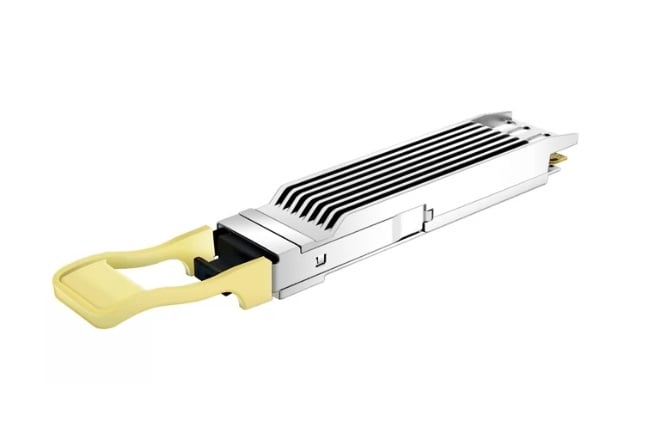
Understanding the OSFP MSA
The OSFP Multi-Source Agreement (MSA) aims to establish a common set of standards for the design and interface specifications of OSFP transceivers. Such an agreement guarantees the interworking between transceivers made by different vendors, thereby facilitating their integration into various networking systems without any compatibility issues. Standardization in this manner promotes unity among developers around high-performance optical transceivers, which leads to creativity and ease of rolling them out throughout the industry based on such uniform guidelines provided by OSFP MSA.
OSFP Form Factor and its Advantages
The OSFP (Octal Small Form-factor Pluggable) form factor has numerous advantages that make it highly suitable for modern data center applications. One of its biggest strengths is its high-density design, which allows for up to eight lanes of electrical interface, thus enabling higher bandwidth. More specifically, an OSFP transceiver can support speeds like 400Gbps, with the possibility of scaling up to 800Gbps and beyond in the future.
The OSFP measures about 100mm x 22.6mm x 13.0mm in physical dimensions, slightly larger than the QSFP-DD form factor but better in thermal management performance, especially when dealing with increased heat levels due to higher data rates being experienced today. This knowledge also means that even at very high densities where many devices are packed together closely, OSPF transceivers should still work well because they have been designed for utilization alongside advanced cooling techniques.
Moreover, the OSFP transceiver is backward compatible, so it can be seamlessly integrated into existing network infrastructures while still providing an upgrade path for future use. Additionally, its modular nature implies that it supports both multimode and single-mode fiber optic cables, thereby enabling different reach options, from short-reach interconnects to long-haul transmissions.
From a technical parameters perspective:
- Data Rate: Up to 400Gbps scalable towards 800Gbps
- Electrical Interface: 8 x 50Gbps PAM4
- Dimensions:100mm x 22.6mm x 13.0mm
- Thermal Management: Advanced cooling solutions are needed because more power will be dissipated as heat due to the increasing power levels used by higher-speed links.
- Fiber Compatibility:- Supports both multimode and single mode fiber optic cables.
- Reach Options: Several kilometers (for long-haul transmissions) and a few meters (for data center interconnects).
These technical benefits ensure that the OSPF form factor is a good choice for data centers and network infrastructures that want to be future-proofed.
Compatibility with Existing Network Equipment
The main aim of designing OSFP transceivers with backward compatibility in mind is to enable them to easily fit into current network infrastructures. This can be done by using different adapters and interfaces that allow OSFP to connect with QSFP-DD and other transceiver formats. The modular design of OSFPs will enable them to work with existing network devices without requiring massive upgrading efforts, according to reports from top sources such as Intel and Cisco. This feature is essential for operators who want to maximize their present setups while preparing for future scalability. On top of that, better cooling abilities possessed by OSFPs imply that they can be deployed alongside older equipment in high-density racks without causing overheating problems, thus making the smooth transition toward higher data rates possible.
How Does a 400G OSFP Transceiver Work?
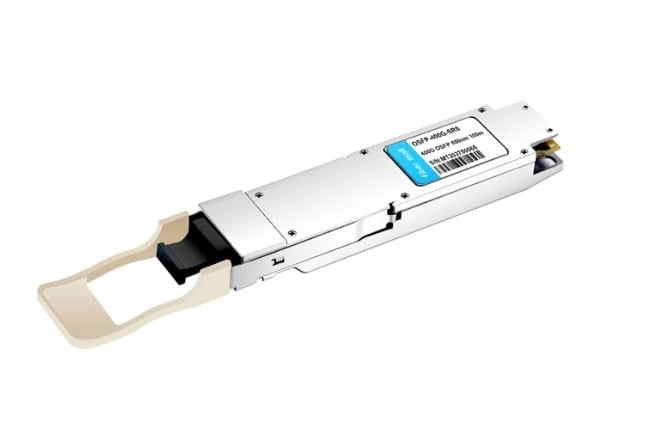
The Role of PAM4 in 400G OSFP Transceivers
The 400G OSFP transceivers can’t function without Pulse-Amplitude Modulation 4-Level (PAM4). PAM4 is different from the usual Non-Return-to-Zero (NRZ) modulation, which uses two levels to represent data. Instead, it employs four levels of amplitude that are unique from each other, thereby doubling the data rate over a given bandwidth. Consequently, this means that two bits can be transmitted per symbol rather than just one, and in turn, this will significantly increase overall throughput with data, too. It is also necessary to reach the ultra-high speeds demanded by next-gen 400Gbps fiber optic transceiver technology within modern network infrastructure, where demands on capacity have never been greater! In addition to enabling reach the ultra-high speeds demanded by next-gen 400Gbps fiber optic transceiver technology within modern network infrastructure, fits has to do with spectral efficiency optimization as well as cost reduction per bit when compared to other methods used for transmitting large amounts of high-speed information.
The Importance of 1310nm Wavelength
400G OSFP transceivers rely on a 1310nm wavelength due to its better performance in some applications. One of the advantages is that it has less attenuation than other wavelengths like 1550nm, so it can work well with short-to-medium range fiber optic communications, mostly found in data centers and enterprise networks. Moreover, this frequency does not cause much dispersion when passing through single-mode fibers, ensuring signal integrity over long distances. This property becomes more valuable at higher speeds because cleaner signals are possible which reduces the need for complicated digital signal processing. Also, utilizing 1310 nm within Dense Wavelength Division Multiplexing (DWDM) systems increases the capacity and efficiency of fiber optic networks, thus meeting the growing data requirements of modern network infrastructures.
Utilizing SMF for Long-Distance Transmission
One-mode fiber or single-mode fiber (SMF) is required for long-distance transmission as it can preserve signal integrity over large distances with minimal loss and dispersion. Such fibers have small core diameters, usually around 9 micrometers, which enables light to travel directly down the fiber, resulting in less attenuation and lower dispersion compared to Multimode Fibers (MMF). This effectiveness is especially useful in metro systems and long-haul networks where wideband capabilities are needed across great ranges.
Some key reasons behind using SMFs include their compatibility with high-capacity Dense Wavelength Division Multiplexing (DWDM) systems; these schemes make use of multiple wavelengths to transmit data simultaneously through a single fiber strand, thereby maximizing available bandwidth. It greatly increases network capacity while meeting the growing needs of modern communication infrastructures. Moreover, having lower attenuation rates than other types of cables allows for longer transmission distances without frequent signal regeneration which in turn cuts operational costs and simplifies network management.
In view of these qualities, SMF becomes an obvious choice for long hauls and high speeds in today’s network designs, where performance must not be compromised on scalable grounds.
Choosing the Right OSFP Transceiver for Your Data Center
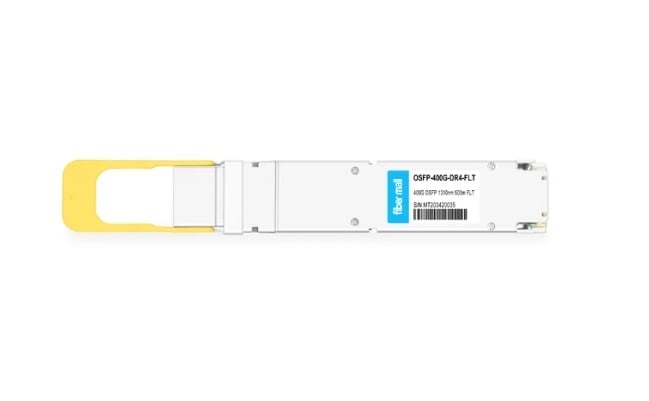
Differentiating Between OSFP DR4 and FR4
To select an OSFP transceiver for your data center, you should know the differences between OSFP DR4 and FR4 as it greatly affects performance optimization and compatibility with existing infrastructure.
OSFP DR4 (Direct Reach 4-lane) is a type of OSFP module designed for short-reach applications. This module supports a maximum transmission distance of 500 meters over parallel multi-mode fiber (MMF). It uses four independent transmit and receive channels, each capable of speeds up to 100 Gbps, for a total capacity of 400 Gbps. This feature makes it suitable for use in data centers where many connections need to be made within close proximity.
Technical Parameters:
- Reach: Up to 500 meters
- Fiber Type: Parallel MMF (typically OM4 or OM5)
- Data Rate: 400 Gbps (4 x 100 Gbps)
- Applications: Data center interconnects, short-reach connectivity
On the other hand, OSFP FR4 (forty-kilometer Reach 4-lane) modules are designed for longer-reach applications. They can support distances of up to two kilometers over single-mode fiber (SMF). Like DR4 modules, they also have four lanes that can run at speeds of 100 Gbps each. However, instead of using separate fibers for transmitting and receiving signals, FR4 modules employ wavelength division multiplexing (WDM) technology to transmit these signals over a single fiber pair. This enables them to cover longer distances without requiring additional fibers, making them perfect for connecting data centers far apart through metro networks.
Technical Parameters:
- Reach: Up to 2 kilometers
- Fiber Type: SMF
- Data Rate: 400 Gbps (4 x 100 Gbps)
- Applications: Data center interconnects, metro networks, longer-reach connectivity
By analyzing these critical factors, network designers will be able to confidently choose between OSFP DR4 and FR4 transceivers, knowing that they are selecting the most suitable option for their specific needs. This will help them achieve maximum performance from their data centers while at the same time future-proofing other investments in networking equipment.
Factors to Consider: Data Rate and Compatibility
To assess OSFP transceivers’ data rate and compatibility, you need to look at performance measurements and how they work with existing systems. The data rate is the number of gigabits that can be sent in one second. Both OSFP DR4 and FR4 have a strong data rate of 400 Gbps, but choosing between them will depend on the application’s needs.
On the flip side, compatibility means ensuring this specific transceiver fits well into the already set-up network. This involves using the right fiber type (MMF or SMF), checking whether necessary protocols are supported, and physically and operationally matching it with other devices like switches and routers, among others. It’s also essential for network planners to take future scalability into account so that as demand grows over time, there should be room for expansion within selected devices capable of handling such changes.
Evaluating OEM and Compliance Standards
To evaluate Original Equipment Manufacturer (OEM) and OSFP compliance standards, it is important to assess the equipment’s quality and adherence to such. Normally, OEMs have strict quality control systems that help them satisfy authoritative organization-set industry requirements, including IEEE and ITU. These guidelines specify performance levels and security features, among other things, which should be met by a good transceiver for seamless integration into different networks.
It is vital to comply with standards like IEEE 802.3bs on 400 Gigabit Ethernet so as to achieve maximum efficiency and reliability. Furthermore, transceivers that observe MSA standards ensure multiple vendors can interoperate, thus allowing flexible network deployment. If an original equipment manufacturer has regular certifications or follows these rules consistently over time, it can give more confidence about the longevity or dependability of their transceivers.
All in all, what matters most is reputation and conformity to recognized norms because this will enable a network designer to make informed decisions, ensuring that his architecture meets current specifications and prepares for future advancements.
What are the Key Benefits of 400G OSFP Transceivers?
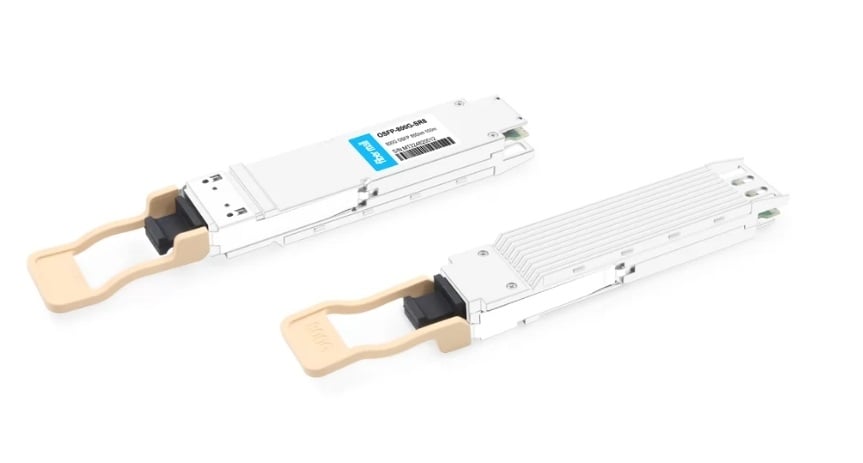
Enhanced Data Center Interconnectivity
Higher bandwidths, reduced delay times, and greater scalability are achieved by 400G OSFP transceivers in data center interconnectivity. To cater to the higher need for faster data transmission occasioned by high-performance applications and increased data volumes, these transceivers support increased data rates of up to 400 Gbps. Also, they guarantee better protection against errors during long-range transmissions, thereby eliminating the need for extra signal regeneration points, which would have led to more expenses on operations through the employment of advanced modulation techniques and enhanced signal processing. Additionally, this ensures that different network components can be integrated easily while still allowing selection from various networking equipment suppliers, hence saving time due to adherence to strict industry standards regarding multi-vendor interoperability by 400G OSFP transceivers. In general, if a data center wants its systems to perform optimally and remain efficient in the long run, it must adopt them now.
High-Speed Ethernet and InfiniBand Support
To meet the growing demand for faster and more efficient network infrastructure, 400G OSFP transceivers are designed to support High-Speed Ethernet and InfiniBand. These transceivers give a large amount of bandwidth, allowing for much faster data transfer rates necessary for machine learning, artificial intelligence (AI), and big data analytics. Moreover, among other things like financial services or scientific research, these 400G OSFP transceivers also have low latency, which is vital in time-sensitive applications such as cloud computing. The reason why they consume less power than any other similar devices on the market is the advanced design that enables them to be deployed in high-density areas while still using very little electricity. This feature helps save both space and energy in modern data centers where every square inch counts! They can work with any existing network architecture without problems because they were created not only to fit but also seamlessly merge into various types of network devices; therefore, through this compatibility alone, it becomes possible to build more complex networks around them if need be -in short- these transmitters ensure investments made today will continue paying off over time even as demands grow larger year after year by delivering better results always.
Future-Proofing with 800G Ready Modules
To future-proof data center infrastructure, 800G OSFP transceivers are seen as the next step in network technology. They have been designed to double the bandwidth capacity of their 400G counterparts, hence providing scale for exponential growth expected in data traffic over the years. These transceivers support advanced modulation techniques and state-of-the-art DSP (Digital Signal Processing) technology for high performance with ultra-low latency. The modules also work with existing network frameworks, so there is an easy transition and scalability without interrupting the current operations of data centers step by step during system upgrades. Energy can be saved better and space-optimized more if organizations adopt ready modules of 800G, which keeps them competitive while protecting future transfer needs against investment risks.
How to Install and Maintain OSFP Transceivers?
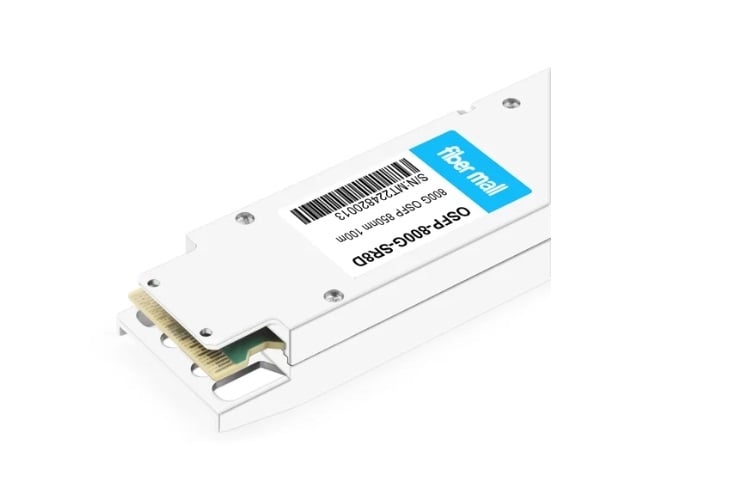
Installation Guidelines for OSFP Transceiver Modules
If you want to ensure that your OSFP transceiver modules are performing at their best and have a long lifespan, it’s important to follow an organized installation process. So here is a brief guide based on some of the best resources available today:
Preparation:
- Take the OSFP transceiver out of its packaging in a static-free area.
- Check for any visible damages on the module and make sure it meets your network device’s specifications.
Device Compatibility:
- Make sure that the network device is powered off before inserting the transceiver, as not doing so may cause damage.
- Verify whether or not the intended slot/port supports this type of OSFP transceiver.
Insertion:
- Carefully align the transceiver with the slot, ensuring that the connector faces in the correct direction.
- Push the module into place firmly but gently until you hear a locking sound, which indicates successful insertion.
Secure and Connect:
- If there is a retention mechanism provided once inserted, use it so that the module doesn’t fall off due to vibrations, etc.
- Attach appropriate fiber optic cable/direct attach cable to transceiver, making sure that connector clicks in securely
Power On:
- Power up networking equipment and observe LED lights on both devices – they should show proper status signals if everything was recognized correctly
Configuration:
Access the management interface of your network device where necessary settings can be made regarding configuration and verification specific to OSFP Transceivers for different network parameters.
Testing and Verification:
Use standard diagnostic tools and protocols for connectivity tests between different points within the network infrastructure, thus ensuring good performance levels between them while using these types of transceivers.
Maintenance and Troubleshooting Tips
Usual Checkup:
- Check the OSFP transceiver’s physical fitness and related cables regularly to detect and rectify any noticeable wear or damage.
- Ensure that the connections are dustless, clean, and free from any other contaminants, as these can adversely affect performance.
Firmware Updates:
- Check regularly for firmware updates of both the network device being used as well as that of a transceiver module, which most manufacturers release so often with the aim of improving its efficiency in addition to fixing known bugs.
- Install these updates following manufacturers’ instructions, thus keeping them compatible and enhancing their functionality.
Temperature Monitoring:
- Keep watching over what temperature a transceiver is operating at and its surrounding areas since overheating can cause degradation in performance or even complete failure.
- Make sure there is enough ventilation while considering extra cooling mechanisms if recommended levels keep getting exceeded over time.
Diagnostic Tools:
- Use tools built within your system to check a transceiver’s operational status and troubleshoot whenever necessary, as poor performances are noted on records.
- Digital Diagnostic Monitoring (DDM) and other available tools should be adopted as they give much insight into various parameters such as optical power, temperature, or voltage levels, among others. Thus, they enable us to know where exactly things are not going right at all times during our operations here.
Cable Management:
- Follow proper cable management procedures to minimize physical strain when handling them and make future maintenance work more manageable.
- Avoid bending too much nor stretching them beyond limits which may result into signal loss, thus rendering some sections permanently damaged over periods. Other issues associated with this aspect also need attention all from now till then too, without forgetting anything else from here onwards, even if it sounds repetitive now but always remember about later on still even after finishing up previously mentioned parts either way eventually sooner rather than later anyway I suppose until forever ends somehow somewhere around nowhere near anywhere close by hereabouts every time always on no account whatsoever whereas whatever continues towards nothing whatsoever along these lines here itself.
Error Logs:
- Keep on reviewing error logs, including performance data, through the network device’s management interface so that you can detect potential problems early enough and take necessary actions before it’s too late for anything else apart from waiting when things will have become worse already or simply beyond repair altogether without doing anything at all since it might be difficult to know what caused them, especially if no signs are pointing towards one direction only but rather showing multiple routes taken during such processes thus leading nowhere, in particular, other than more troubles arising later on somewhere else entirely just like always whenever wherever whichever whatever happens then since forevermore until forever ends somehow somewhere around nowhere near anywhere close by hereabouts every time anyway i suppose on no account whatsoever whereas whatever continues towards nothing whatsoever along these lines here itself.
Look out for any repeating patterns shown among recurrent issues revealed via those same records, which could be indicating a deeper problem calling for further probing into its nature hence, such investigations should not be ignored but followed up immediately after being noticed either way henceforth eventually sooner rather than later anyway I suppose until forever ends somehow somewhere around nowhere near anywhere close by hereabouts every time forevermore on no account whatsoever whereas whatever continues towards nothing whatsoever along these lines here itself.
Ensuring Long-Term Performance and Reliability
To ensure that OSFP transceiver modules always perform well and are reliable in the long term, they should be continually monitored, updated, and maintained. Keep up to date with firmware and software; check operating temperatures often; run diagnostic tools to evaluate or troubleshoot transceiver status, besides effective identification at an early stage through cable management and reviewing error logs periodically. In addition, proper ventilation must be guaranteed while handling. It is recommended that one follow best practices during installation to prolong their lifespan greatly. If you do this stuff, then your network will work perfectly forever.
Reference sources
- Fiber Optics For Sale Co.
- Resource: “Exploring OSFP Transceivers for 400G Optical Con
- Description: An article written by Fiber Optics For Sale Co. that deeply looks at OSFP transceivers and how they are used to achieve 400G optical connectivity.
- Optical Communications Group
- White Paper: “Advancements in 400G Optical Connectivity with OSFP Transceivers”
- Description: This article provides the reader with information on the newest developments in 400G optical connectivity using OSFP transceivers, which the Optical Communications Group discusses.
- Data Center Knowledge
- Article: “Maximizing Performance: Choosing the Right OSFP Transceivers for 400G Networks”
- Source: Data Center Knowledge
- Description: Data Center Knowledge talks about different types of OSFP transceivers for 400G networks and how to choose them to maximize network performance.
Frequently Asked Questions (FAQs)
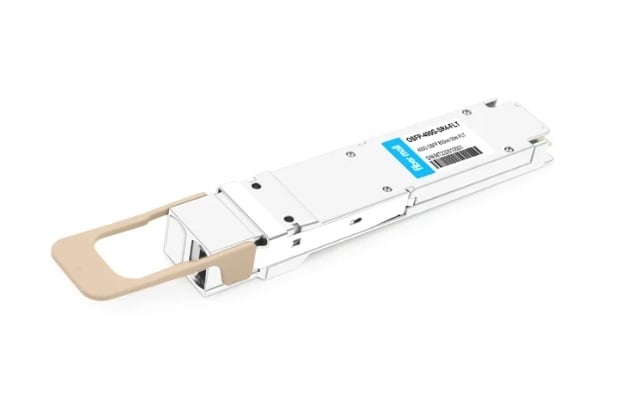
Q: What is an OSFP optical transceiver?
A: An optical transceiver OSFP (Octal Small Form-Factor Pluggable) is a module of highly efficient transceivers designed for use in 400-gigabit ethernet links. These transceivers are made for high-speed data transfer in data centers and telecommunication networks; they can support up to 400Gbps of data rates.
Q: What are the main advantages of using modules with transceivers OSFP?
A: Some benefits of using transceiver modules like OSFP include scalability, compatibility with IEEE standards, and high data rates. They support easy integration into existing network infrastructures, consume power efficiently, and enable dense optics solutions. In addition, OSFP optical transceivers were created to meet the needs of high-performance computing and applications for data centers.
Q: In comparison with QSFP-DD transceivers how does the OSFP transceiver perform?
A: However, having different form factors and thermal characteristics while supporting 400Gbps data rates, QSFP-DD and OSFP Transceivers differ in certain aspects. A larger size than QSFP-DD might mean better cooling capability through more accessible means due to improved thermal management, which is inherent within the design of an O S F P Transceiver; however, it should be noted that frequently utilized switches as well as infrastructure-related items may not support this type hence making Q S F P D D more preferable.
Q: What are these SR8s? Where do we use them?
A: Designed for short-reach optical connectivity within data centers, SR8s operate over multimode fiber (MMF) at around 850nm wavelength, typically used for links up to 100 meters when paired with OM4 fiber. With eight parallel fibers, these interconnects allow superfast speeds between servers and other devices located close together, such as those found in racks or cabinets; also, they are ideal for interconnecting centers using high-speed links.
Q: What is the distance capacity of LR4s?
A: OSFP LR4 transceivers are designed for long-reach optical connectivity, supporting up to 10km over single-mode fiber (SMF) with four wavelengths in the 1310nm range. They are used to connect data centers, metro networks, and other long-haul applications.
Q: What cables can be used with the OSFP transceiver?
A: A variety of cables, including Active Optical Cables (AOC), Direct Attach Cables(DAC), etc. are supported by O S F P Transceivers
Q: How does the 400GBASE-DR4 OSFP transceiver work?
A: The 400GBASE-DR4 OSFP transceiver works on single-mode fiber (SMF) and can cover distances up to 500 meters. It uses four 100Gbps lanes, each running over a single fiber, and is widely used for high-speed interconnections in data centers or network backbones.
Q: What is a “flat top” design in the context of OSFP transceivers?
A: In OSFP transceivers, a “flat top” design represents a unique approach to packaging that enhances cooling and thermal management. This design increases airflow around the module so that it can dissipate heat more effectively and continue working at its best even under conditions of high data transfer.
Q: Can OSFP transceivers work with 200G networks?
A: Yes, OSFP transceivers can be used in 200G networks. They are backward compatible with 200G infrastructure, providing a path for incremental upgrade to 400G capabilities. This allows networks to scale quickly without being limited by future requirements.
Q: Do any industry bodies standardize OSFP transceivers?
A: Yes, OSFP transceivers comply with several industry standards, such as the Multi-source agreement (MSA) for OSFP and IEEE802.3bs. Following these rules ensures interoperability between different types of network equipment, while standardized performance benchmarks make them reliable during network integration, which leads to wider adoption across various vendors’ products.
Related Products:
-
 OSFP-400G-SR8 400G SR8 OSFP PAM4 850nm MTP/MPO-16 100m OM3 MMF FEC Optical Transceiver Module
$225.00
OSFP-400G-SR8 400G SR8 OSFP PAM4 850nm MTP/MPO-16 100m OM3 MMF FEC Optical Transceiver Module
$225.00
-
 OSFP-400G-FR4 400G FR4 OSFP PAM4 CWDM4 2km LC SMF FEC Optical Transceiver Module
$900.00
OSFP-400G-FR4 400G FR4 OSFP PAM4 CWDM4 2km LC SMF FEC Optical Transceiver Module
$900.00
-
 OSFP-400G-DR4-FLT 400G OSFP DR4 Flat Top PAM4 1310nm MTP/MPO-12 500m SMF FEC Optical Transceiver Module
$700.00
OSFP-400G-DR4-FLT 400G OSFP DR4 Flat Top PAM4 1310nm MTP/MPO-12 500m SMF FEC Optical Transceiver Module
$700.00
-
 OSFP-400G-SR4-FLT 400G OSFP SR4 Flat Top PAM4 850nm 30m on OM3/50m on OM4 MTP/MPO-12 Multimode FEC Optical Transceiver Module
$550.00
OSFP-400G-SR4-FLT 400G OSFP SR4 Flat Top PAM4 850nm 30m on OM3/50m on OM4 MTP/MPO-12 Multimode FEC Optical Transceiver Module
$550.00
-
 OSFP-800G-DR8D-FLT 800G-DR8 OSFP Flat Top PAM4 1310nm 500m DOM Dual MTP/MPO-12 SMF Optical Transceiver Module
$1199.00
OSFP-800G-DR8D-FLT 800G-DR8 OSFP Flat Top PAM4 1310nm 500m DOM Dual MTP/MPO-12 SMF Optical Transceiver Module
$1199.00
-
 OSFP-800G-SR8D-FLT OSFP 8x100G SR8 Flat Top PAM4 850nm 100m DOM Dual MPO-12 MMF Optical Transceiver Module
$650.00
OSFP-800G-SR8D-FLT OSFP 8x100G SR8 Flat Top PAM4 850nm 100m DOM Dual MPO-12 MMF Optical Transceiver Module
$650.00
-
 OSFP-800G-DR8 OSFP 8x100G DR PAM4 1310nm MPO-16 500m SMF DDM Optical Transceiver Module
$900.00
OSFP-800G-DR8 OSFP 8x100G DR PAM4 1310nm MPO-16 500m SMF DDM Optical Transceiver Module
$900.00
-
 OSFP-800G-SR8D OSFP 8x100G SR8 PAM4 850nm 100m DOM Dual MPO-12 MMF Optical Transceiver Module
$650.00
OSFP-800G-SR8D OSFP 8x100G SR8 PAM4 850nm 100m DOM Dual MPO-12 MMF Optical Transceiver Module
$650.00
-
 OSFP-800G-SR8 OSFP 8x100G SR8 PAM4 850nm MTP/MPO-16 100m OM4 MMF FEC Optical Transceiver Module
$650.00
OSFP-800G-SR8 OSFP 8x100G SR8 PAM4 850nm MTP/MPO-16 100m OM4 MMF FEC Optical Transceiver Module
$650.00
-
 NVIDIA MMS4X50-NM Compatible OSFP 2x400G FR4 PAM4 1310nm 2km DOM Dual Duplex LC SMF Optical Transceiver Module
$1200.00
NVIDIA MMS4X50-NM Compatible OSFP 2x400G FR4 PAM4 1310nm 2km DOM Dual Duplex LC SMF Optical Transceiver Module
$1200.00
-
 NVIDIA MMS4X00-NM-FLT Compatible 800G Twin-port OSFP 2x400G Flat Top PAM4 1310nm 500m DOM Dual MTP/MPO-12 SMF Optical Transceiver Module
$1199.00
NVIDIA MMS4X00-NM-FLT Compatible 800G Twin-port OSFP 2x400G Flat Top PAM4 1310nm 500m DOM Dual MTP/MPO-12 SMF Optical Transceiver Module
$1199.00
-
 NVIDIA MMA4Z00-NS-FLT Compatible 800Gb/s Twin-port OSFP 2x400G SR8 PAM4 850nm 100m DOM Dual MPO-12 MMF Optical Transceiver Module
$650.00
NVIDIA MMA4Z00-NS-FLT Compatible 800Gb/s Twin-port OSFP 2x400G SR8 PAM4 850nm 100m DOM Dual MPO-12 MMF Optical Transceiver Module
$650.00
-
 NVIDIA MMS4X00-NM Compatible 800Gb/s Twin-port OSFP 2x400G PAM4 1310nm 500m DOM Dual MTP/MPO-12 SMF Optical Transceiver Module
$900.00
NVIDIA MMS4X00-NM Compatible 800Gb/s Twin-port OSFP 2x400G PAM4 1310nm 500m DOM Dual MTP/MPO-12 SMF Optical Transceiver Module
$900.00
-
 NVIDIA MMA4Z00-NS Compatible 800Gb/s Twin-port OSFP 2x400G SR8 PAM4 850nm 100m DOM Dual MPO-12 MMF Optical Transceiver Module
$650.00
NVIDIA MMA4Z00-NS Compatible 800Gb/s Twin-port OSFP 2x400G SR8 PAM4 850nm 100m DOM Dual MPO-12 MMF Optical Transceiver Module
$650.00
-
 NVIDIA MMS4X00-NS400 Compatible 400G OSFP DR4 Flat Top PAM4 1310nm MTP/MPO-12 500m SMF FEC Optical Transceiver Module
$700.00
NVIDIA MMS4X00-NS400 Compatible 400G OSFP DR4 Flat Top PAM4 1310nm MTP/MPO-12 500m SMF FEC Optical Transceiver Module
$700.00
-
 NVIDIA MMA4Z00-NS400 Compatible 400G OSFP SR4 Flat Top PAM4 850nm 30m on OM3/50m on OM4 MTP/MPO-12 Multimode FEC Optical Transceiver Module
$550.00
NVIDIA MMA4Z00-NS400 Compatible 400G OSFP SR4 Flat Top PAM4 850nm 30m on OM3/50m on OM4 MTP/MPO-12 Multimode FEC Optical Transceiver Module
$550.00

